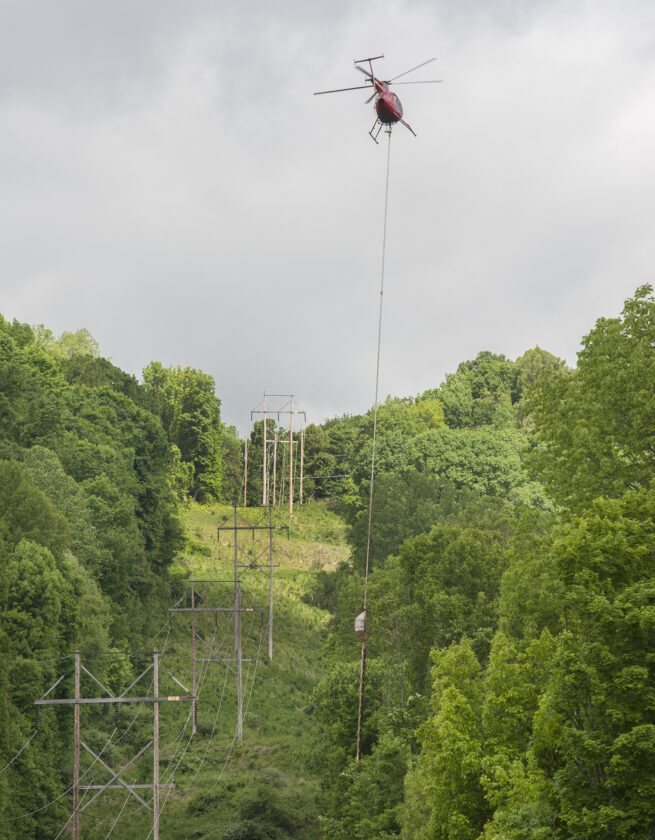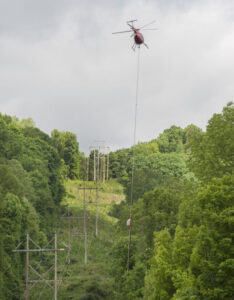Trees, storms drive spike in power outages

Photo submitted to the Times Observer A tree-trimming helicopter is pictured in 2023.
Coming off a year with the most power outages in 30 years in Pennsylvania, two state lawmakers are proposing separate bills to strengthen the power grid.
In 2024, Pennsylvania experienced 71 “reportable outage events” – the highest number recorded in more than 30 years – disrupting electric service for residents and businesses across the state, according to the Pennsylvania Public Utility Commission’s (PUC) latest Electric Service Reliability Report.
The 71 outage events in 2024 marked a sharp increase from 49 events in 2023 and were accompanied by a significant rise in the total number of customers affected. More than 2.8 million Pennsylvanians lost service at some point during the year, compared to 1.67 million in 2023. These figures underscore the continued challenges posed by severe storms, vegetation-related damage, and the impacts of an aging power grid.
The PUC report highlights that most of Pennsylvania’s 11 electric distribution companies (EDCs) struggled to meet established reliability benchmarks in 2024. Of note, only three EDCs achieved the Commission’s standard performance metrics across all categories for both the year-end and rolling three-year averages.
While the deployment of advanced grid technologies continues to help utilities reduce the number of customers impacted during outage events, those same technologies can sometimes lengthen the duration of repairs in the hardest-hit areas due to the complexity of the damage.
This trend – fewer customers experiencing outages during some events but longer outages for those affected – reinforces the need for sustained investments in utility infrastructure and vegetation management, the PUC report states.
Nine of the Commonwealth’s 11 EDCs have approved Long-Term Infrastructure Improvement Plans that the PUC said are critical for addressing aging equipment and enhancing system resilience. Utilities with significant investments in these programs have historically been among the best performers in meeting reliability benchmarks, although even these utilities faced challenges during 2024. The PUC continues to emphasize the importance of balancing reliability improvements with affordability for consumers, noting that utilities must carefully weigh infrastructure and vegetation management investments alongside the impact of costs on customers.
As in past years, severe weather and vegetation remain the leading causes of outages in Pennsylvania, according to the PUC. In particular, storms that topple off-right-of-way trees and bring down overhanging limbs from weakened canopy trees accounted for the majority of 2024’s disruptions. Storm activity acts upon the vulnerability of weakened trees in the overhanging canopy, and OROW trees. The PUC’s Bureau of Technical Utility Services is urging power companies to reexamine and strengthen their vegetation management and capital improvement programs to address these ongoing threats. The report also notes that utilities should explore new technologies and practices – such as advanced monitoring tools, improved conductor protection, and targeted undergrounding – to reduce risks while balancing the cost impacts on ratepayers.
FirstEnergy Corp. continued its aerial tree trimming program in Warren County earlier this year, using a helicopter-mounted saw to clear vegetation along high-voltage transmission lines. The work will continue through the end of 2025.
The program aims to ensure the reliability of power systems by maintaining proper tree clearances along more than 400 miles of electric transmission lines in hard-to-access or environmentally sensitive areas. The aerial saw-suspended beneath a helicopter and equipped with 24-inch rotary blades-can trim branches 8 to 10 inches thick with speed and precision.
FirstEnergy’s aerial saw operations are part of a $51 million vegetation management effort in the Penelec service area this year. In addition to Warren, trimming is taking place in Bedford, Blair, Bradford, Cambria, Centre, Clearfield, Elk, Huntingdon, McKean, Mifflin, Potter, Somerset, Tioga, Westmoreland and Wyoming counties.
Ground crews accompany the helicopter to assist in clearing fallen limbs from roads, driveways, streams, and other areas. Safety measures, including road flagging and coordination with local airports, are strictly observed to ensure public and worker safety.
The trimming program helps reduce tree-related outages-especially during severe summer and winter storms-and supports easier access for emergency repairs.





